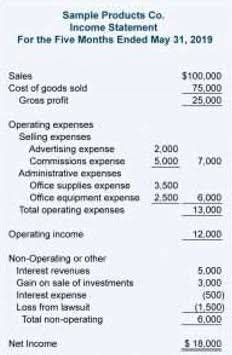
Failure to comply and meet these obligations by the company can lead to legal consequences. The business might have to face financial penalties, censures, and reputational damage, and in some cases, the directors might face jail time. Legal compliance involves the process wherein a company adheres to the complex laws, policies, and procedures that regulate business practices in payroll expenses a particular jurisdiction. It is about knowing and understanding the laws that apply to your company and ensuring that the company always complies with them. The employer’s relationship with employees is also governed by legal aspects.
Factors Influencing Payroll Costs
These online systems can also allow people to track their spending to see if they’re meeting their budgets. Whatever the size or nature of your business, your payroll is something you have to manage carefully. Payroll can be a complex issue to understand, especially as the many rules and regulations governing it are constantly changing. The ATO has set out guidelines to determine whether you are hiring an employee or contractor. Some contractors, those paid mostly for their labour, may also be deemed to be employees for superannuation purposes. Currently it is levied at 10% of Ordinary Times Earnings with a scheduled progression to 12% by 2025.
What are Payroll Expenses?
Many types of cloud-based accounting software are available for small businesses as well. The type of industry and number of employees are two factors that will dictate which is appropriate. A freelancer wouldn’t require the same features in a piece of accounting software as a restaurant owner. Small business owners benefit from accounting software because it helps them track accounts receivable and accounts payable, gauge their profitability, and prepare for tax season. A small business can use out-of-the-box software without requiring extensive customizations. The automated payroll system is a software system that automatically completes payroll processing instead of the tedious manual process.
- It can happen only when employees come into work thinking about how they could make a difference to your business.
- To understand these differences, review each payroll component and determine if it is a business expense.
- Automated payroll software is easier to use than your standard payroll program, and reduces human intervention and errors.
- While you can’t avoid overtime entirely, you can look for ways to keep it manageable.
- The amount of insurance premiums that have not yet expired should be reported in the current asset account Prepaid Insurance.
- Following IRS and state guidelines, employers must keep detailed records of all payroll transactions, including gross pay, deductions, net pay, and tax filings.
Payroll taxes and insurance
The term may also be assumed to include the cost of all related payroll taxes, such as the employer’s matching payments for Medicare and social security. You can calculate gross wages by multiplying Accounting for Churches your employees’ hourly wage amount by the number of hours they work during your payroll period. Don’t forget to factor in any overtime pay, which is paid at a rate of one and a half times the hourly wage. Compensation for employees that is in addition to salaries and wages. Generally, the cost of fringe benefits should be expensed when they are earned by the employee, not in the period in which they are paid. Let’s continue with our example of the payroll for the hourly-paid employees.
- Proactively planning your payroll expansion will better equip you with an efficient workforce of your choice to sail through the challenges of the growth phase.
- For example, if the amount deducted from the employee’s salary is $16.30, then the employer must contribute $22.82.
- For salaried employees, the agreed-upon annual salary is divided by the number of pay periods.
- The best payroll software will also offer insights into spending patterns, helping you make informed financial decisions, ensuring compliance with tax regulations, and reducing the risk of costly penalties.
- As the most common type of payroll, it falls into the wages and salaries category and includes overtime, bonuses and commissions.

Beyond labor, payroll expenses should account for employer taxes, including FICA, FUTA, and SUTA. These expenses are often grouped under “payroll taxes” in the financial ledger, helping distinguish them from gross wages. Each payroll cycle, these withholdings are reported to the IRS through payroll tax filings, such as Form 941 for federal income tax and FICA, and deposited according to federal and state guidelines. At the end of the year, employers must provide employees with a W-2 form summarizing annual earnings, taxes withheld, and FICA contributions.
- Employee retention matters to every business because recruiting employees is a time-consuming and expensive overhead.
- Your business’s payroll budget comprises expenses directly related to employees, including gross wages, commissions, and taxes.
- A small business can use out-of-the-box software without requiring extensive customizations.
- Additionally, just like the EI, CPP has a maximum amount – the contribution limit for CPP in 2023 is $66,600.
- Gusto Payroll is a cloud-based payroll solution designed to simplify and streamline the payroll process for businesses.
- For the workweek of December 18–24, the gross wages are $1,000 for hourly employees in the delivery department and $1,300 for employees in the warehouse.
Automate Payroll Tasks to Save Time
The FICA tax rate is 7.65%, allotted 1.45% for Medicare and 6.2% for Social Security taxes. Other tax rates will be determined by Federal, state, or local laws and the information included on your employee’s W-4. Their company pays employees every two weeks for a total of 26 pay periods. The law requires that overtime hours over 40 hours per week be paid at one-and-a-half times the regular hourly rate. Some employees are exempt from the FLSA and the Act doesn’t apply to independent contractors or volunteers because they’re not considered employees. Employers with gross sales of $500,000 or more per year are subject to the requirements of the Fair Labor Standards Act (FLSA) passed in 1938.
Payroll Expenses FAQs
This tends to be a lot simpler than calculating payroll for employees since you only need to consider gross pay. However, it can sometimes be a bit trickier to project total payroll expenses for contractors over a given period depending on their contract terms. Net pay is the amount an employee receives after all payroll deductions. You’ll use the employee’s gross wages, the information they provided on Form W-4 (and the equivalent state income tax form), and their benefits elections to calculate net pay.

When the business owner pays cash on April 5, the liability balance decreases. Additionally, employers often consider a Christmas bonus as part of payroll expenses, providing an extra incentive or reward for employees during the holiday season. Payroll expense may be included in the cost of manufactured goods or billed services, in which case it is reported within the cost of goods sold section of the income statement. If manufactured goods are not sold in the same period, then payroll expense may be capitalized into the inventory asset until sold. If payroll expense relates to general, selling, and administrative activities, then it is reported as an operating expense in the lower half of the income statement in the period in which it was incurred.

If the withholdings are for amounts that are due the company (such as employees’ share of insurance premiums or amounts how is sales tax calculated owed by employees for company merchandise), no remittance is required. Rather, the journal entry reflects a credit that reduces the company’s insurance expense or reduces the company’s receivables from employees. In this explanation of payroll accounting we will highlight some of the federal and state payroll-related regulations and provide links to some of the government agencies and publications. We conclude with sample accounting entries that a company will record so that its financial statements reflect the accrual basis of accounting. On the other hand, the company must report to the Internal Revenue Service (IRS) the amounts it has paid to its employees.
